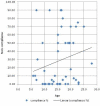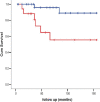Phenotypic and genetic characterization of a cohort of pediatric Wilson disease patients
- PMID: 21682854
- PMCID: PMC3132721
- DOI: 10.1186/1471-2431-11-56
Phenotypic and genetic characterization of a cohort of pediatric Wilson disease patients
Abstract
Background: In Egypt, Wilson disease seems to be under diagnosed and clinical data on large cohorts are limited. The aim of this study is to highlight the clinical, laboratory and genetic characteristics of this disease in our pediatric population as well as to report our experience with both treatment options and outcome.
Methods: The study included 77 patients from 50 unrelated families (62 were followed up for a mean period of 58.9 ± 6.4 months and 27 were asymptomatic siblings). Data were collected retrospectively by record analysis and patient interviews. Diagnosis was confirmed by sequencing of the ATP7B gene in 64 patients.
Results: Our patients had unique characteristics compared to other populations. They had a younger age of onset (median: 10 years), higher prevalence of Kayser-Fleischer rings (97.6% in the symptomatic patients), low ceruloplasmin (93.5%), high rate of parental consanguinity (78.9%) as well as a more severe course. 71.42% of those on long term D-penicillamine improved or were stable during the follow up with severe side effects occurring in only 11.5%. Preemptive treatment with zinc monotherapy was an effective non-toxic alternative to D-penicillamine. Homozygous mutations were found in 85.7%, yet limited by the large number of mutations detected, it was difficult to find genotype-phenotype correlations. Missense mutations were the most common while protein-truncating mutations resulted in a more severe course with higher incidence of acute liver failure and neurological symptoms.
Conclusions: Egyptian children with Wilson disease present with early Kayser-Fleischer rings and early onset of liver and neurological disease. The mutational spectrum identified differs from that observed in other countries. The high rate of homozygous mutations (reflecting the high rate of consanguinity) may potentially offer further insights on genotype-phenotype correlation.
Figures



Similar articles
-
[Wilson disease: an update].Korean J Hepatol. 2006 Sep;12(3):333-63. Korean J Hepatol. 2006. PMID: 16998287 Review. Korean.
-
Disturbed copper transport in humans. Part 2: mutations of the ATP7B gene lead to Wilson disease (WD).Cell Mol Biol (Noisy-le-grand). 2001;47 Online Pub:OL149-57. Cell Mol Biol (Noisy-le-grand). 2001. PMID: 11936861
-
Truncating mutations in the Wilson disease gene ATP7B are associated with very low serum ceruloplasmin oxidase activity and an early onset of Wilson disease.BMC Gastroenterol. 2010 Jan 18;10:8. doi: 10.1186/1471-230X-10-8. BMC Gastroenterol. 2010. PMID: 20082719 Free PMC article.
-
Distinct clinical courses according to presenting phenotypes and their correlations to ATP7B mutations in a large Wilson's disease cohort.Liver Int. 2011 Jul;31(6):831-9. doi: 10.1111/j.1478-3231.2011.02503.x. Epub 2011 Mar 13. Liver Int. 2011. PMID: 21645214
-
Wilson disease.Med Electron Microsc. 2002 Jun;35(2):61-6. doi: 10.1007/s007950200007. Med Electron Microsc. 2002. PMID: 12181646 Review.
Cited by
-
Phenotype-genotype correlation in Wilson disease in a large Lebanese family: association of c.2299insC with hepatic and of p. Ala1003Thr with neurologic phenotype.PLoS One. 2014 Nov 12;9(11):e109727. doi: 10.1371/journal.pone.0109727. eCollection 2014. PLoS One. 2014. PMID: 25390358 Free PMC article.
-
Addressing the Challenges in the Diagnosis and Management of Pediatric Wilson's Disease-Case Report and Literature Review.Medicina (Kaunas). 2023 Apr 18;59(4):786. doi: 10.3390/medicina59040786. Medicina (Kaunas). 2023. PMID: 37109744 Free PMC article. Review.
-
Spectrum of Pathogenic Variants of the ATP7B Gene and Genotype-Phenotype Correlation in Eastern Eurasian Patient Cohorts with Wilson's Disease.Biomedicines. 2024 Dec 13;12(12):2833. doi: 10.3390/biomedicines12122833. Biomedicines. 2024. PMID: 39767741 Free PMC article.
-
Efficacy and safety of D-penicillamine, trientine, and zinc in pediatric Wilson disease patients.Orphanet J Rare Dis. 2024 Jul 9;19(1):261. doi: 10.1186/s13023-024-03271-1. Orphanet J Rare Dis. 2024. PMID: 38982450 Free PMC article.
-
Wilson's disease in Lebanon and regional countries: Homozygosity and hepatic phenotype predominance.World J Gastroenterol. 2017 Sep 28;23(36):6715-6725. doi: 10.3748/wjg.v23.i36.6715. World J Gastroenterol. 2017. PMID: 29085216 Free PMC article.
References
-
- Loudianos G, Dessi V, Lovicu M, Angius A, Figus A, Lilliu F, Nurchi AM, Deplano A, Moi P, Pirastu M, Cao A. Molecular characterization of Wilson's disease in the Sardinian population-evidence of a founder effect. Hum Mutat. 1999;14:294–303. doi: 10.1002/(SICI)1098-1004(199910)14:4<294::AID-HUMU4>3.0.CO;2-9. - DOI - PubMed
-
- Scheinberg IH. Wilson's disease. J Rheumatol Suppl. 1981;7:90–93. - PubMed
MeSH terms
Substances
LinkOut - more resources
Full Text Sources
Medical
Molecular Biology Databases

